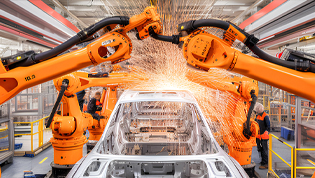Release time:2024-07-15 17:39:28 Number of clicks:441
This issue introduces another emerging chassis electronic control product - active lateral stabilizer bar. At present, the international active lateral stabilizer bar is mainly used in passenger models that emphasize driving control performance, such as: Audi SQ7/SQ8, Volkswagen Touareg, Lotus Eletre and Emeya, BMW X5/X6/X7, Porsche Cayenne/Palamela, Bentley Tien Yue and so on. This issue introduces how active lateral stabilizer bars can improve vehicle comfort, handling, and safety. For convenience, this article refers to the Active lateral stabilizer bar as ARC (Active Roll Control).
Since the active horizontal stabilizer bar is evolved from the traditional passive horizontal stabilizer bar (hereinafter referred to as "passive stabilizer bar"), it is necessary to have a basic understanding of the passive stabilizer bar. The passive stabilizer bar is an Anti-roll bar, literally translated as "anti-roll bar". As we all know, in the process of vehicle driving, the body of the excessive left and right direction, front and rear direction of the shaking or swinging will bring discomfort to the driver and passenger, and serious body roll, such as the vehicle at high speed, sharp turns, may trigger the vehicle to roll outward, causing casualties.
The passive stabilizer bar is a horizontal, flexible torsion bar with one front axle and one rear axle. If you look down on the vehicle, a passive stabilizer bar is in a U shape that is stretched laterally, and the U word is open to the direction of the vehicle forward or reverse. The left and right rocker arms of the passive stabilizer bar are fixed to the body, and the cross bar in the middle is fixed to the frame by bushings that allow rotation.

Passive stabilizer bar layout
When the vehicle turns at high speed, the centrifugal force will make the body tilt outward (roll), the outer rocker arm of the passive stabilizer bar is therefore pressed downward, and the torque generated will be transmitted to the inner rocker arm, which will also pull the inner body down, so as to alleviate the body tilt outward amplitude, which is the principle of the passive stabilizer bar "anti-roll". However, when the undulation of the road hits one side of the wheel and the body, the torque generated on that side will also be transmitted to the other side of the wheel and the body, making the driver and passenger feel uncomfortable. That is to say, under the two contradictory performance requirements of effective anti-roll and guarantee comfort, the passive stabilizer rod will be in a dilemma.
To solve this problem, ARC (active lateral stabilizer bar) came into being. The ARC system is configured on the front and rear axles, each with sensors, controllers, and actuators consisting of a drive motor and a deceleration mechanism that turns the left and right rocker arms in reverse when the motor is driven (side-looking vehicle). The basic structure and chassis layout of ARC system are shown as follows:

ARC system structure

ARC system chassis layout
Let's take a look at the basic principle of ARC when the vehicle is moving. When the vehicle is driving in a straight line, there is no power signal to the motor, ARC can be disconnected from the left and right, and the left and right wheels can beat independently, at this time, the road impact on one side will not be transmitted to the other side, which can avoid derivative impact and ensure driving comfort. When the vehicle is steering, it is divided into two conditions: steering wheel rotation (transient) and steering wheel static (steady state). When the steering wheel rotates, based on steering wheel Angle, speed, lateral acceleration, yaw Angle speed and other signals, the motor drives the two ends of the stabilizer bar to reverse twist to control the tilt attitude of the body, so that the body can maintain a horizontal (or even tilt inward to the anti-centrifugal) attitude; When the steering wheel is stationary but the vehicle is still turning, the motor and the deceleration mechanism lock the stabilizer bar into one, in order to maintain the current body attitude until the turn is completed. After the wheel is back to normal, ARC enters the state of no electric signal of the motor. The following table illustrates typical ARC driving scenarios:

ARC action principle overview
In summary, the overall performance of the ARC system is far better than that of the passive stabilizer bar in terms of controlling the body attitude and reducing the impact of the road surface.

Comparison diagram of anti-roll effect of passive stabilizer bar and ARC
In addition, with the ARC system, the vehicle can also have a number of practical and cool features, such as: lower one side of the body, to achieve convenient boarding and unloading of passengers; For example, when the vehicle falls into the snow or silt road surface, it can achieve escape by shaking the body from left to right; Another example: when the vehicle is about to be hit by another vehicle coming from the side at high speed, in order to avoid the door being directly hit and hurt the occupants, ARC can quickly tilt the body to the side without impactors, so that the high-strength longitudinal beam below the door can accept the impact to achieve the protection of the occupants.















